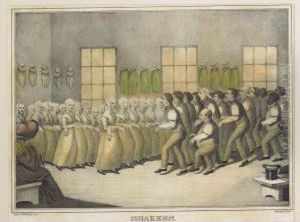Thomas S. Sinclair Paintings
Thomas S. Sinclair was born in the year 1805 in Belfast, Northern Ireland. He was not primarily known as a fine artist; rather, he made his mark as a lithographer. Lithography, which was invented in the late 18th century, became a popular form of printing in the 19th century, particularly for reproducing images.
Sinclair moved to the United States in his early twenties, settling in Philadelphia, which was a burgeoning center for the arts and printing industries in America. His career in lithography began there, and by the mid-19th century, he had established his own firm, Thomas Sinclair & Co., which became one of the prominent lithographic establishments in the city.
The firm specialized in color printing and was notable for producing a wide range of materials, including maps, advertisements, portraits, and scientific illustrations. During the American Civil War, the company produced a number of prints related to the conflict, capturing scenes of battles and military figures. These works were not only significant as historical records but also as pieces of art that helped shape the public's perception of the war.
Sinclair's firm contributed to the development of American lithography, adapting to the changing technologies and tastes of the time. Although Sinclair is not widely remembered today as an individual artist, his contribution to the printing industry and the dissemination of visual culture in the 19th century was significant. His work reflects the era's merging of art and industry, and his firm's prints are now valuable for their historical and artistic merit.
Thomas S. Sinclair died in 1881 in Philadelphia. His legacy continues in the collections of historical societies and museums that preserve 19th-century American lithographs, demonstrating the role his firm played in the visual documentation of American history.
